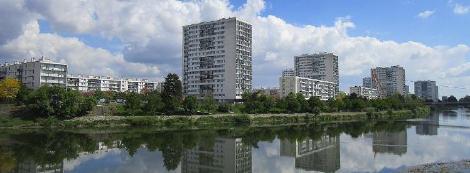Priority urban neighbourhoods (QPV)
July 2022
The areas defined as priority neighbourhoods for urban policy are among the most disadvantaged in France, and therefore face a number of socio-economic challenges. Knowing the main characteristics of these neighbourhoods enables us to understand their needs and implement solutions that can be developed there. This presentation is taken from a dossier produced by the AVISE association on the role of the SSE in these neighbourhoods.

Urban policy and priority neighbourhoods
Urban policy has two major aims: to reduce the development gap between disadvantaged neighbourhoods and their urban units, and to improve the living conditions of their residents. It covers all urban, economic and social issues and mobilises all sectoral policies and measures. Urban policy has its own specific resources:
-
at national level: a dedicated State budget programme, as well as schemes run by the ANCT (programme de réussite éducative, cités éducatives, ateliers santé-ville, programme adultes-relais, cités de l’emploi, PaQte, etc.);
-
at local level: the city contract, a local partnership tool.
In response to the cumulative difficulties faced by residents of disadvantaged neighbourhoods, and in order to better target its interventions, urban policy is based on a priority geography. This comprises 1,514 priority neighbourhoods (QPV) located in 859 municipalities. The method used to identify these neighbourhoods is based on a fine grid of urban areas with a high concentration of low-income residents.
City contracts are concluded at the inter-municipal level. They must be part of an integrated approach involving the State and its public bodies, local authorities (EPCIs and communes) and other institutional players (social welfare organisations, housing bodies, economic players), as well as civil society (via neighbourhood councils in particular). The city contracts are based on 3 pillars: social cohesion; development of economic activity and employment; living environment and urban renewal. Signed in 2015 and extended until 2023, the 435 city contracts formalising the commitments of the signatories are currently being evaluated.
On 14 April 2022, an urban policy history committee was set up. Its main aims are « to encourage study and research into the history of urban policy and urban social development, to promote the dissemination of historical works on urban policy, and to identify and promote urban policy archives, organise collections of personal accounts and study days on the history of urban policy, mobilise players to facilitate the emergence of local projects based on the history of urban policy and interest the general public in the history of urban policy and the actions carried out in favour of the neighbourhoods concerned and their residents « 4.
The challenges for priority urban neighbourhoods
Today, almost 5 million people live in the 1,500 poorest neighbourhoods in France and its overseas territories (200 neighbourhoods are located in Guadeloupe, French Guiana, Reunion Island, Martinique, Mayotte and French Polynesia). These neighbourhoods often suffer from a combination of problems, including social segregation, poor access to transport, educational underachievement and remoteness from the main economic, social and cultural centres.
The various studies carried out on the QPVs draw up a typology of their residents. The population of the QPVs is younger, often less educated and more likely to be of foreign origin. There are also twice as many single-parent families, higher levels of unemployment and more precarious forms of employment.
Evaluation of city contracts
The programming law for cities and urban cohesion of 21 February 2014 provides for city contracts to be evaluated, with methodological support from the National Observatory for City Policy (ONPV). Each city contract sets out « the engineering resources for drawing up, running and evaluating the city contract, as well as the indicators for measuring the results obtained. In addition to the indicators available at national level for each priority district, the city contracts include indicators and qualitative assessment elements derived from local observation ». (Source: Programming law for the city and urban cohesion of 21 February 2014)
In addition, on 14 December 2021, the Ministry for Territorial Cohesion and Relations with Local Authorities issued an instruction concerning the local evaluation of city contracts. This specifies the objectives of the evaluation, the priority issues to be addressed in the evaluation, its scope and methodological elements.
Sources
To go further
-
List of QPV: www.data.gouv.fr/fr/datasets/quartiers-prioritaires-de-la-politique-de-la-ville-qpv
-
Atlas of QPVs sig.ville.gouv.fr/atlas/QP_régions
-
A GIS on urban policy sig.ville.gouv.fr/
-
IREV (a resource centre for urban policy in the Hauts-de-France region), with the support of Asdo études, has published the methodological tools and shared reference framework developed as part of the final evaluation of the urban contract in the Hauts-de-France region in 2022. irev.fr/thematiques/methodologie/evaluation-et-demarches-evaluatives/2022-evaluation-des-contrats-de-ville-1
-
The Atelier parisien d’urbanisme (Apur) has published the evaluation framework for the Paris City Contract 2015-2022, as well as the initial results based on data collected in 2020.